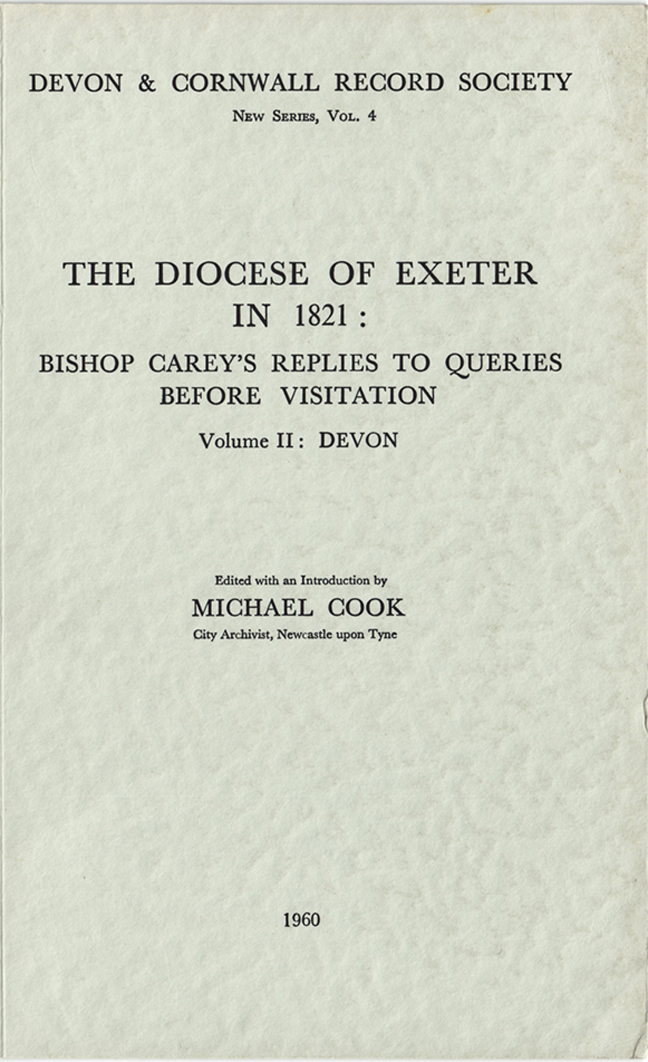246 results
25 Evaluating serum copper and kidney function in a cohort of bariatric surgery patients
- Part of
-
- Journal:
- Journal of Clinical and Translational Science / Volume 8 / Issue s1 / April 2024
- Published online by Cambridge University Press:
- 03 April 2024, p. 7
-
- Article
-
- You have access
- Open access
- Export citation
76 Lessons learned during implementation of OMOP common data model across multiple health systems
- Part of
-
- Journal:
- Journal of Clinical and Translational Science / Volume 8 / Issue s1 / April 2024
- Published online by Cambridge University Press:
- 03 April 2024, p. 20
-
- Article
-
- You have access
- Open access
- Export citation
Index
-
- Book:
- The Diocese of Exeter in 1821
- Published by:
- Boydell & Brewer
- Published online:
- 15 February 2024, pp 195-206
-
- Chapter
- Export citation
Introduction
-
- Book:
- The Diocese of Exeter in 1821
- Published by:
- Boydell & Brewer
- Published online:
- 15 February 2024, pp vii-xix
-
- Chapter
- Export citation
Frontmatter
-
- Book:
- The Diocese of Exeter in 1821
- Published by:
- Boydell & Brewer
- Published online:
- 15 February 2024, pp i-iv
-
- Chapter
- Export citation
Contents
-
- Book:
- The Diocese of Exeter in 1821
- Published by:
- Boydell & Brewer
- Published online:
- 15 February 2024, pp v-v
-
- Chapter
- Export citation
The Bishop's Letter and Queries
-
- Book:
- The Diocese of Exeter in 1821
- Published by:
- Boydell & Brewer
- Published online:
- 15 February 2024, pp 1-2
-
- Chapter
- Export citation
Appendix: Devon Livings of Small Value, 1808
-
- Book:
- The Diocese of Exeter in 1821
- Published by:
- Boydell & Brewer
- Published online:
- 15 February 2024, pp 193-194
-
- Chapter
- Export citation
Abbreviations
-
- Book:
- The Diocese of Exeter in 1821
- Published by:
- Boydell & Brewer
- Published online:
- 15 February 2024, pp vi-vi
-
- Chapter
- Export citation

The Diocese of Exeter in 1821
- Bishop Carey's Replies to Queries before Visitation
-
- Published by:
- Boydell & Brewer
- Published online:
- 15 February 2024
The Replies From the Parishes
-
- Book:
- The Diocese of Exeter in 1821
- Published by:
- Boydell & Brewer
- Published online:
- 15 February 2024, pp 3-192
-
- Chapter
- Export citation
1 Associations of Locus of Control and Memory Self-Awareness in Older Adults with and without MCI
-
- Journal:
- Journal of the International Neuropsychological Society / Volume 29 / Issue s1 / November 2023
- Published online by Cambridge University Press:
- 21 December 2023, pp. 676-677
-
- Article
-
- You have access
- Export citation
Prevalence, risk factors, and outcomes associated with delayed second doses of antibiotics in sepsis at a large academic medical center
-
- Journal:
- Antimicrobial Stewardship & Healthcare Epidemiology / Volume 3 / Issue 1 / 2023
- Published online by Cambridge University Press:
- 10 November 2023, e207
-
- Article
-
- You have access
- Open access
- HTML
- Export citation
Conservation, uncertainty and intellectual humility
-
- Journal:
- Environmental Conservation / Volume 50 / Issue 4 / December 2023
- Published online by Cambridge University Press:
- 09 November 2023, pp. 196-201
-
- Article
-
- You have access
- Open access
- HTML
- Export citation
Characterization of mesosulfuron-methyl + iodosulfuron-methyl and pyroxsulam–resistant annual bluegrass (Poa annua) in an annual cropping system
-
- Journal:
- Weed Science / Volume 71 / Issue 6 / November 2023
- Published online by Cambridge University Press:
- 13 October 2023, pp. 557-564
-
- Article
-
- You have access
- Open access
- HTML
- Export citation
Comparison of the welfare of beef cattle in housed and grazing systems: hormones, health and behaviour
-
- Journal:
- The Journal of Agricultural Science / Volume 161 / Issue 3 / June 2023
- Published online by Cambridge University Press:
- 29 June 2023, pp. 450-463
-
- Article
-
- You have access
- Open access
- HTML
- Export citation
504 A Model for Introducing Biomedical Commercialization and Entrepreneurship Concepts to Research Faculty
-
- Journal:
- Journal of Clinical and Translational Science / Volume 6 / Issue s1 / April 2022
- Published online by Cambridge University Press:
- 19 April 2022, p. 102
-
- Article
-
- You have access
- Open access
- Export citation
Sustaining University Operations During the COVID-19 Pandemic
-
- Journal:
- Disaster Medicine and Public Health Preparedness / Volume 16 / Issue 5 / October 2022
- Published online by Cambridge University Press:
- 08 March 2021, pp. 1901-1909
-
- Article
- Export citation
Contributors
-
- Book:
- Core Topics in Airway Management
- Published online:
- 03 October 2020
- Print publication:
- 03 December 2020, pp vii-xii
-
- Chapter
- Export citation



